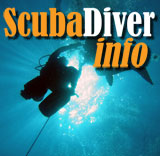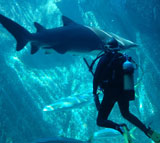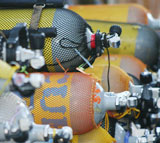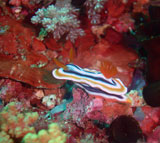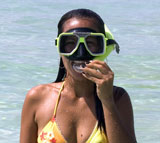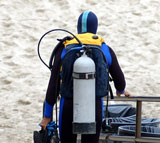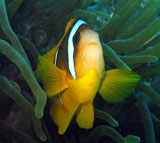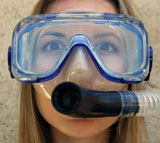Regulators
by Conrad H. Blickenstorfer
The regulator enables you to use the air in your scuba tank. It is the part of your diving gear in charge of regulating air flow between the tank, your mouthpiece and all other hoses and attachments that require air, such as the pressure gauge, the dive computer, a secondary air source, etc.  A regulator is needed to reduce the very high air pressure in the tank to the ambient pressure of the water surrounding you. It does that in two steps. Regulators are also called demand valves because they provide air by opening when the diver demands it by breathing in, and closing when s/he breathes out. A regulator is needed to reduce the very high air pressure in the tank to the ambient pressure of the water surrounding you. It does that in two steps. Regulators are also called demand valves because they provide air by opening when the diver demands it by breathing in, and closing when s/he breathes out.
Regulators actually consist of two stages. The first stage (shown above to the left) attaches to the valve on top of the air tank. The second stage (shown above to the right) is down by the mouthpiece.
The first stage
The task of the first stage is to reduce the pressure in the air tank, usually around 3,000 psi, to an intermediate pressure, usually about 140 to 150 psi. All first stages therefore have two chambers, one that is at the same high pressure as the tank, and the other with intermediate pressure.
 The first stage has a number of ports. Some of them are high pressure ports that connect to the pressure gauge or dive computer. Those ports require special high pressure hoses and have a different thread than the low pressure ports. Low pressure ports connect to low pressure items: the second stage with the mouthpiece, an alternate breathing source, a hose for inflating the BC or dry suit, and perhaps an blower or a hose to power tools. The first stage has a number of ports. Some of them are high pressure ports that connect to the pressure gauge or dive computer. Those ports require special high pressure hoses and have a different thread than the low pressure ports. Low pressure ports connect to low pressure items: the second stage with the mouthpiece, an alternate breathing source, a hose for inflating the BC or dry suit, and perhaps an blower or a hose to power tools.
First stages are manufactured from chrome-plated brass or titanium and there are two different designs. One uses a piston and the other a diaphragm.
Piston first stages are usually less expensive and they are easy to service, but not so easy to adjust should the need arise. Piston designs have few moving parts, are very reliable, and can reach very high air delivery rates. Diaphragm designs, unlike pistons, are totally sealed and do not allow water or debris to enter the stage. They cost more, but are easier for service personnel to adjust.
First stage designs can also be balanced or unbalanced. Balanced refers to a design that delivers the same amount of air regardless of the pressure in the tank or how hard the diver breathes. In unbalanced designs, there is less air as the cylinder pressure falls, making it progressively harder to breathe, though some of the newer unbalanced designs are much improved.
First stages also differ in the number of low pressure ports and the type of valve they connect to (A-clamp "yoke" or DIN fitting, or both). The more ports, the more hoses can be connected, and the easier it is to connect at just the right angle. The first stage shown above to the left uses a yoke design.
Technical divers and those who dive in very cold water may choose specialized first stages. Some of them minimize the use of gaskets and O-rings and use other means of sealing in order to eliminate any possible interaction between special breathing gas and the gaskets. Cold water first stages may use special sealing and coating to eliminate the risk of freezing inside.
The second stage
The primary task of the second stage is to reduce the intermediate air pressure in the hose coming from the first stage down to the exact same pressure as the surrounding water so that breathing is as easy as possible.
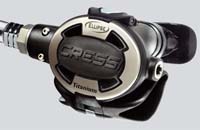 Second stages are made of brass, plastic, or a combination of both, and sometimes even more exotic materials (the second stage shown to the left is Cressi-sub's elliptically shaped Ellipse Titanium which allows for use of a larger diaphragm that the company says results in less breathing effort. This is also one of the lightest second stages available.) The mouthpiece itself is made of plastic, neoprene and silicone. Second stages include the mouthpiece, an exhaust valve and a purge valve that's used to test the regulator and also to clear water or debris that might find its way into the mouthpiece. The purge valve is activated with a purge button. There are different second stage designs with exhaust valves in different locations.
Second stages are made of brass, plastic, or a combination of both, and sometimes even more exotic materials (the second stage shown to the left is Cressi-sub's elliptically shaped Ellipse Titanium which allows for use of a larger diaphragm that the company says results in less breathing effort. This is also one of the lightest second stages available.) The mouthpiece itself is made of plastic, neoprene and silicone. Second stages include the mouthpiece, an exhaust valve and a purge valve that's used to test the regulator and also to clear water or debris that might find its way into the mouthpiece. The purge valve is activated with a purge button. There are different second stage designs with exhaust valves in different locations.
Most modern second stages have a "downstream" inlet valve. This means the valve opens away from the air pressure. If it were to fail, it remains open and continues to deliver air. An "upstream" valve would close, cut off air, and perhaps lead to dangerous overinflation in other parts of the system. You wouldn't want to find yourself without air to breathe and a BC getting overinflated.
Like any other part of the diving gear, manufacturers offer a large variety of second stages of different design and with different features. And each manufacturer has their own patented technologies and materials. There may be antifreeze kits, special orthodontic mouthpieces, vacuum assist for easier breathing, inhalation effort adjustment, dry valve systems to keep water out completely, special balanced valves to minimize the effort to overcome valve resistance, and so on.
What to select
Selecting the right regulator requires quite a bit of research and definitely the advice of a seasoned diving instructor or expert. The various technologies and features do not only have an impact on price, but they also make a regulator more suitable for certain kinds of diving. This can be essential for technical and advanced diving.
Beginning divers should primarily be concerned with the ease of breathing provided by a regulator. You do not want to have to fight the regulator with every breath you take. I also recommend that you pay attention to the mouthpiece. One that does not fit right or has sharp edges can hurt your gums or make it difficult to keep water out. As a result, you may bite too hard on the mouthpiece or get tired from fighting to keep water out.
If you're the kind who likes reviews and tests, know that a collaboration between Scuba Diving Magazine and Scuba Lab periodically publishes reviews of all regulators and also comparison charts. [Click here to view a PDF file of the 2006 Regulator Chart and here to see the magazine's 2006 full new regulator reviews].
What goes where??
Given how important the delivery of air is to a scuba system, you'd expect everything to be obvious and fool-proof. Not so. As anyone who has taken a first look at a regulator with its hoses, mouthpieces, instruments and whatever hanging off it can attest, it isn't easy to figure out what goes where. Yes, a yoke regulator can be hooked up to a tank two different ways (one being right and one being wrong), and it is also possible to have the part with all those low pressure hoses face up or down. It is VERY easy for new divers to get it wrong. So here's the right way to set things up with a yoke-type regulator:
Stand your tank in front of you and put the BC (buoyancy compensator) strap around it. The tank's on/off valve knob should point to the right. Now undo the yoke screw knob and put the yoke over the tank's valve so that the yoke knob points towards you, and the part of the regulator with the mouthpiece and secondary air source hoses coming out of it faces down, not up! If you do it this way, you're fine.
Examples of Regulators
The Scubapro MK25/S600 regulator combo consists of the MK25 balanced first stage and the S600 second stage. 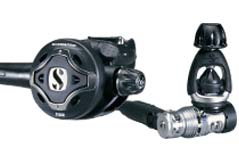 The MK25 is a piston controlled first stage packed with patented features that ensure unfailing performance. The system provides extremely high and smooth air delivery and very stable intermediate pressure, resulting in instant and constant high delivery of air. There are two high-pressure and four low-pressure ports. The MK25 has a robust chrome plated brass body and components. The otherwise idential MK25T uses titanium, shaving off a bit of weight.
The MK25 is a piston controlled first stage packed with patented features that ensure unfailing performance. The system provides extremely high and smooth air delivery and very stable intermediate pressure, resulting in instant and constant high delivery of air. There are two high-pressure and four low-pressure ports. The MK25 has a robust chrome plated brass body and components. The otherwise idential MK25T uses titanium, shaving off a bit of weight.
The S600 second stage is a compact, light-weight air balanced design based on a variety of Scubapro patents. It was conceived with virtual elimination of breathing effort in mind. There is adjustable inhalation control via a knob, a large and soft purge, and oversized controls for easy operation. The S600 has an orthodontic silicone mouthpiece, uses antifreeze materials for enhanced cold water performance, and is highly corrosion resistant.
Oceanic's Alpha 8 is for recreational divers looking for professional performance at a reasonable price.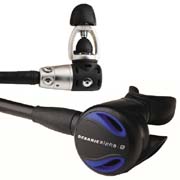 Its PX-3 Balanced Piston first stage is a balanced design so that air flow volume is unaffected by depth or tank pressure. Swiveled low pressure ports and the addition of a 5th LP port make it easy to route low pressure hoses for the second stage, alternate air source, BC power inflator, or drysuit any way the diver wants. The Alpha 8 is suitable for use with nitrox containing up to 40% oxygen by volume without the need for special preparation, cleaning or component parts. The second stage features a patented orthodontic mouthpiece, designed to accommodate the natural overbite of the human jaw. The Alpha 8 is available in various yoke and DIN configurations. Its PX-3 Balanced Piston first stage is a balanced design so that air flow volume is unaffected by depth or tank pressure. Swiveled low pressure ports and the addition of a 5th LP port make it easy to route low pressure hoses for the second stage, alternate air source, BC power inflator, or drysuit any way the diver wants. The Alpha 8 is suitable for use with nitrox containing up to 40% oxygen by volume without the need for special preparation, cleaning or component parts. The second stage features a patented orthodontic mouthpiece, designed to accommodate the natural overbite of the human jaw. The Alpha 8 is available in various yoke and DIN configurations.
Blast from the Past
Retro design is big these days, as evidenced by the New Beetle, the Mini Cooper, the PT Cruiser, the new Ford Mustang and others. But did you know you can also get a "retro" regulator? 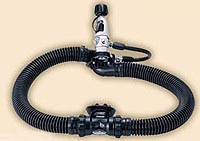 That would be the Aqua Lung Mistral that recreates the look of those two hose regulators the Cousteau divers used early on. The first and second stage are combined and mounted at the tank, behind the diver's head. There are two hoses, one for supply air and the other for exhaust air. That means all air bubbles exit behind the diver's head, which can be a good thing especially for photographers. Likewise, since the two hoses are separated, moist air isn't blown into the second stage, and the danger of freezing is reduced. Reviews indicate that the Mistral breathes easily in most positions, except, unfortunately in the standard swimming position where breathing effort goes up. Still, it's an elegant design that undoubtedly holds appeal to some divers. That would be the Aqua Lung Mistral that recreates the look of those two hose regulators the Cousteau divers used early on. The first and second stage are combined and mounted at the tank, behind the diver's head. There are two hoses, one for supply air and the other for exhaust air. That means all air bubbles exit behind the diver's head, which can be a good thing especially for photographers. Likewise, since the two hoses are separated, moist air isn't blown into the second stage, and the danger of freezing is reduced. Reviews indicate that the Mistral breathes easily in most positions, except, unfortunately in the standard swimming position where breathing effort goes up. Still, it's an elegant design that undoubtedly holds appeal to some divers.
|
